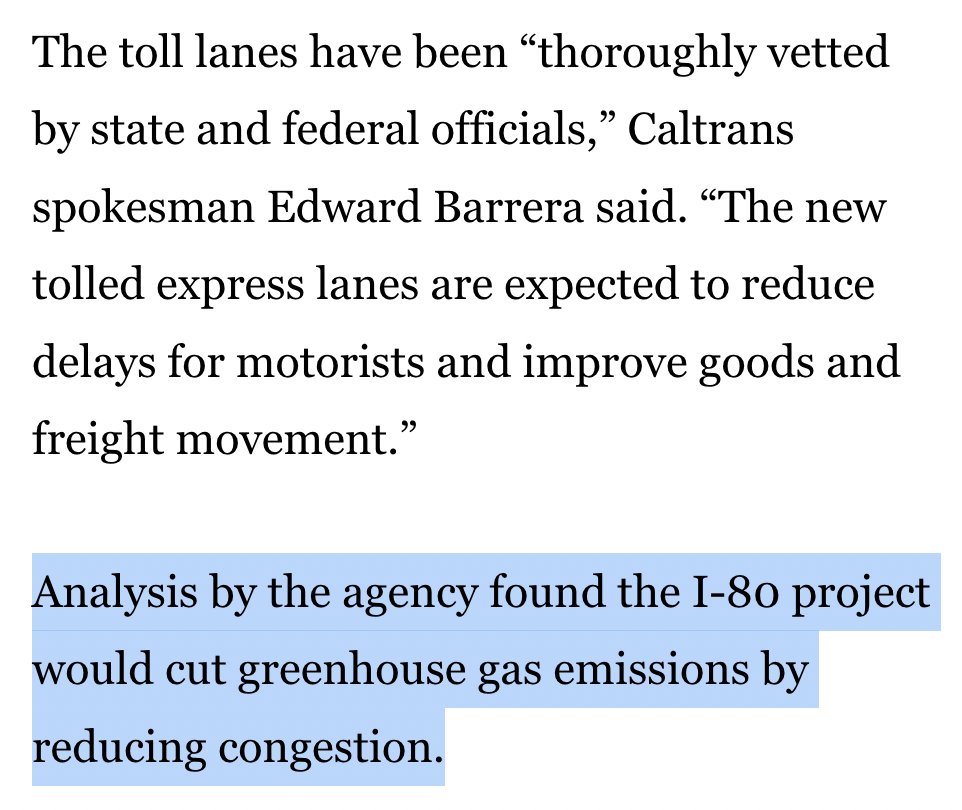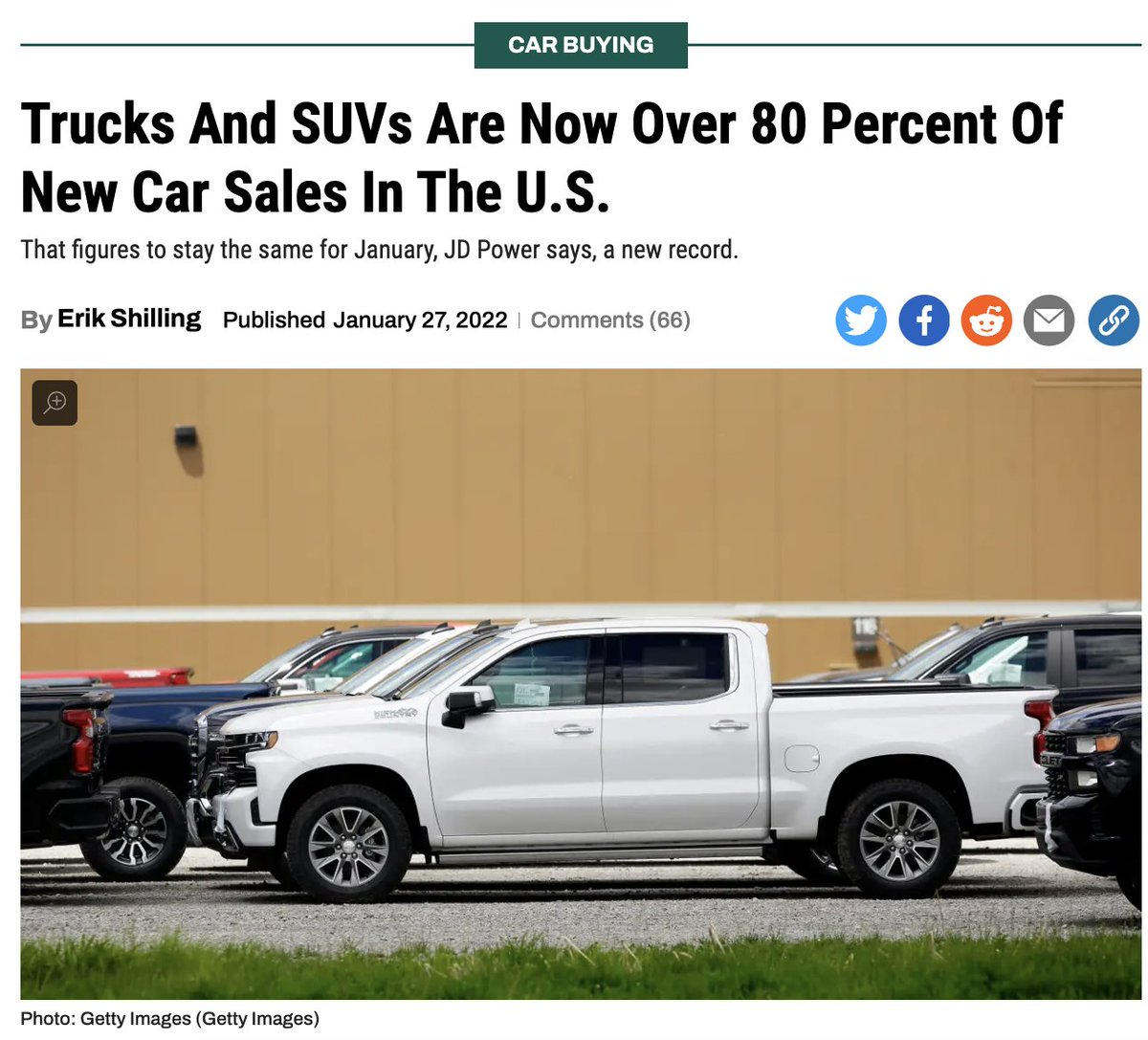I’ve spent much of this year learning about car bloat, the process through which smaller vehicles are being replaced by increasingly massive SUVs and trucks.
What I’ve learned: Huge cars are terrible for society, often in ways that are hidden.
A summary 🧵
What I’ve learned: Huge cars are terrible for society, often in ways that are hidden.
A summary 🧵

First, some basic info:
🔹 >80% of US car sales are now trucks/SUVs. Europe is behind, but catching up.
🔹 Models keep expanding. Ex: The 2023 F-150 is ~800 lbs heavier and 7 in taller than in 1991.
🔹 EVs can make the problem worse due to huge batteries.
jalopnik.com/trucks-and-suv…
🔹 >80% of US car sales are now trucks/SUVs. Europe is behind, but catching up.
🔹 Models keep expanding. Ex: The 2023 F-150 is ~800 lbs heavier and 7 in taller than in 1991.
🔹 EVs can make the problem worse due to huge batteries.
jalopnik.com/trucks-and-suv…
Problem 1: Car bloat endangers others on the street
Tall vehicles have bigger blind spots and are more likely to strike a person’s torso or head.
Heavier vehicles exert more force crashing into a person, bicycle, or smaller car. They also have longer braking distances.
Tall vehicles have bigger blind spots and are more likely to strike a person’s torso or head.
Heavier vehicles exert more force crashing into a person, bicycle, or smaller car. They also have longer braking distances.

Problem 2: Car bloat worsens climate change
Heavier cars require more energy to move, which makes them guzzle gas.
When electrified, their huge batteries are so inefficient that the biggest models generate more pollution that some gas-powered sedans.
fastcompany.com/90854942/the-b…
Heavier cars require more energy to move, which makes them guzzle gas.
When electrified, their huge batteries are so inefficient that the biggest models generate more pollution that some gas-powered sedans.
fastcompany.com/90854942/the-b…
Problem 3: Car bloat shreds tires
Heavier cars exert more pressure on tires, eroding them faster.
Tire particles are absorbed into water, where they damage ecosystems. They also float through the air, harming human health when ingested.
theatlantic.com/technology/arc…
Heavier cars exert more pressure on tires, eroding them faster.
Tire particles are absorbed into water, where they damage ecosystems. They also float through the air, harming human health when ingested.
theatlantic.com/technology/arc…
Problem 4: Car bloat destroys roadways
Cars have become so heavy that US autohaulers can’t carry a full load w/o exceeding federal weight limits.
Car companies and truckers are asking Congress to raise those limits – but doing so would pulverize asphalt.
slate.com/business/2023/…
Cars have become so heavy that US autohaulers can’t carry a full load w/o exceeding federal weight limits.
Car companies and truckers are asking Congress to raise those limits – but doing so would pulverize asphalt.
slate.com/business/2023/…
Problem 5: Car bloat makes cars expensive
Big, heavy cars can be sold for more $. That’s why Stellantis CEO Sergio Marchionne made a famous pivot away from sedans in 2016, a move other carmakers followed.
It’s a key reason cars have become so pricey.
money.com/average-new-ca…
Big, heavy cars can be sold for more $. That’s why Stellantis CEO Sergio Marchionne made a famous pivot away from sedans in 2016, a move other carmakers followed.
It’s a key reason cars have become so pricey.
money.com/average-new-ca…
Even some automakers are recognizing the dangers of car bloat and calling for change.
Here is Stellantis' CTO in a recent interview.
https://t.co/DvCOODDByXeurope.autonews.com/automakers/why…

Here is Stellantis' CTO in a recent interview.
https://t.co/DvCOODDByXeurope.autonews.com/automakers/why…

Some might say: “But people want big cars!”
Not necessarily. US automakers offer no alternative, and car bloat pushes buyers to upsize – if only to avoid being at a disadvantage on the road b/c *others* have big cars.
slate.com/business/2022/…
Not necessarily. US automakers offer no alternative, and car bloat pushes buyers to upsize – if only to avoid being at a disadvantage on the road b/c *others* have big cars.
slate.com/business/2022/…
Summary: Car bloat is terrible – for road safety, for the planet, for equity, and for road maintenance.
But bigger cars are often more profitable, so automakers like making them.
The only way out: Government action
theatlantic.com/ideas/archive/…
But bigger cars are often more profitable, so automakers like making them.
The only way out: Government action
theatlantic.com/ideas/archive/…
What should we do?
🔹 Tax vehicles by weight.
🔹 Test vehicles for pedestrian and cyclist safety (still doesn’t happen in the US)
🔹 Require a CDL for the most gigantic vehicles
Left alone, this problem will only worsen. Governments must step up.
slate.com/business/2023/…
🔹 Tax vehicles by weight.
🔹 Test vehicles for pedestrian and cyclist safety (still doesn’t happen in the US)
🔹 Require a CDL for the most gigantic vehicles
Left alone, this problem will only worsen. Governments must step up.
slate.com/business/2023/…
• • •
Missing some Tweet in this thread? You can try to
force a refresh
























